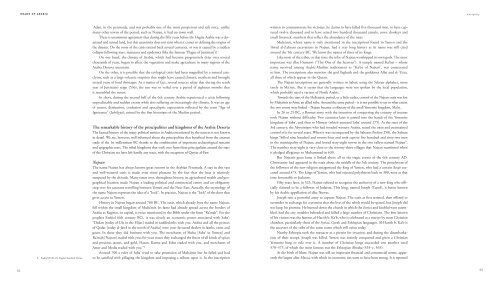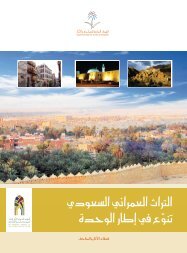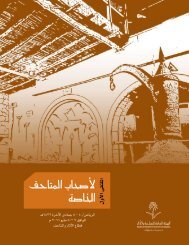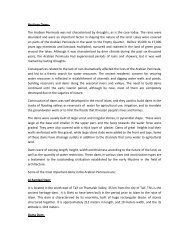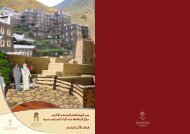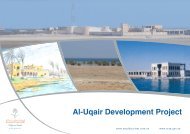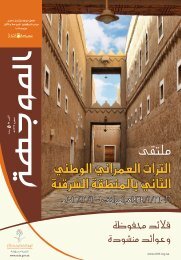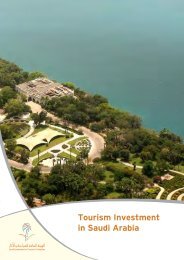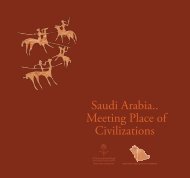Roads of Arabia
Roads of Arabia
Roads of Arabia
You also want an ePaper? Increase the reach of your titles
YUMPU automatically turns print PDFs into web optimized ePapers that Google loves.
04 Arabie US_p080-99_BAT.qxd 23/06/10 19:42 Page 92<br />
ROADS OF ARABIA<br />
Antiquity<br />
4. Ezekiel 27:20–23, English Standard Version.<br />
’Adan, in the peninsula, and was probably one <strong>of</strong> the most prosperous and safe since, unlike<br />
many other towns <strong>of</strong> the period, such as Najran, it had no town wall.<br />
There is unanimous agreement that during the fifty years before the Hegira <strong>Arabia</strong> was a devastated<br />
and ruined land, but this unanimity does not exist when it comes to defining the origins <strong>of</strong><br />
the disaster. Do the roots <strong>of</strong> the crisis extend back several centuries, or was it caused by a sudden<br />
collapse following wars, massacres and epidemics (like the famous “Plague <strong>of</strong> Justinian”)?<br />
On one hand, the climate <strong>of</strong> <strong>Arabia</strong>, which had become progressively drier over several<br />
thousands <strong>of</strong> years, began to affect the vegetation and make agriculture in many regions <strong>of</strong> the<br />
<strong>Arabia</strong> Deserta uncertain.<br />
On the other, it is possible that the ecological crisis had been magnified by a natural cataclysm,<br />
such as a large volcanic eruption that might have caused climatic mayhem and brought<br />
several years <strong>of</strong> food shortages. As a matter <strong>of</strong> fact, several sources relate that during the tenth<br />
year <strong>of</strong> Justinian’s reign (536), the sun was so veiled over a period <strong>of</strong> eighteen months that<br />
it resembled the moon.<br />
In short, during the second half <strong>of</strong> the 6th century <strong>Arabia</strong> experienced a crisis following<br />
unpredictable and sudden events while also suffering an increasingly dry climate. It was an age<br />
<strong>of</strong> unrest, destitution, confusion and apocalyptic expectation reflected by the term “Age <strong>of</strong><br />
Ignorance” (Jahiliyya), coined by the first historians <strong>of</strong> the Muslim period.<br />
The remarkable history <strong>of</strong> the principalities and kingdoms <strong>of</strong> the <strong>Arabia</strong> Deserta<br />
The factual history <strong>of</strong> the many political entities in <strong>Arabia</strong> mentioned by the sources is not known<br />
in detail. We are, however, well informed about the principalities that benefited from the caravan<br />
trade <strong>of</strong> the 1st millennium BC thanks to the combination <strong>of</strong> important archaeological remains<br />
and epigraphic texts. The tribal kingdoms that took over from these principalities around the start<br />
<strong>of</strong> the Christian era have left hardly any trace, with the exception <strong>of</strong> Qaryat al-Faw.<br />
Najran<br />
The name Najran has always known great renown in the <strong>Arabia</strong>n Peninsula. A stay in this vast<br />
and well-watered oasis is made even more pleasant by the fact that the heat is relatively<br />
tempered by the altitude. Many times over, throughout history, its agricultural wealth and geographical<br />
location made Najran a leading political and commercial centre and an obligatory<br />
stop over for caravans travelling between Yemen and the Near East. Actually, the etymology <strong>of</strong><br />
the name Najran expresses the idea <strong>of</strong> a “lock”. In practice, Najran is the “lock” <strong>of</strong> the door that<br />
gives access to Yemen.<br />
History in Najran began around 700 BC. The oasis, which already bore the name Najran,<br />
fell within the small kingdom <strong>of</strong> Muha’mir. Its fame had already spread across the borders <strong>of</strong><br />
<strong>Arabia</strong> as Ragmat, its capital, is twice mentioned in the Bible under the form “Ra’mah”. For the<br />
prophet Ezekiel (6th century BC), it was clearly an economic power associated with Saba’:<br />
“Dedan [today al-Ula in the Hijaz] traded in saddlecloths with you. <strong>Arabia</strong> and all the princes<br />
<strong>of</strong> Qedar [today al-Jawf in the north <strong>of</strong> <strong>Arabia</strong>] were your favoured dealers in lambs, rams and<br />
goats. In these they did business with you. The merchants <strong>of</strong> Sheba [Saba’ in Yemen] and<br />
Ra‘mah [Najran] traded with you; for your wares they exchanged the finest <strong>of</strong> all kinds <strong>of</strong> spices<br />
and precious stones, and gold. Haran, Kanne and Eden traded with you, and merchants <strong>of</strong><br />
Assur and Media traded with you.” 4<br />
Around 700 a ruler <strong>of</strong> Saba’ tried to take possession <strong>of</strong> Muha’mir but he failed and had<br />
to be satisfied with pillaging the kingdom and imposing a tribute upon it. In the inscription<br />
written to commemorate his victories, he claims to have killed five thousand men, to have captured<br />
twelve thousand and to have seized two hundred thousand camels, cows, donkeys and<br />
small livestock, numbers that reflect the abundance <strong>of</strong> the oasis.<br />
Muha’mir, whose name is only mentioned in the inscriptions found in Yemen and the<br />
‘Awad al-Zahrani excavations in Najran, had a very long history as its name was still cited<br />
around the 5th century BC. We know the names <strong>of</strong> three <strong>of</strong> its kings.<br />
Like most <strong>of</strong> the tribes, at that time the tribe <strong>of</strong> Najran worshipped its own gods. The most<br />
important was dhu l-Samawi (“The One <strong>of</strong> the heavens”). A temple named Ka’bat – whose<br />
name survived among Arabic-Muslim traditionists as “Ka’ba <strong>of</strong> Najran”, was consecrated<br />
to him. The inscriptions also mention the god Yaghuth and the goddesses Allat and al-’Uzza,<br />
all three <strong>of</strong> which appear in the Quran.<br />
The Najran inscriptions are generally written in Sabaic using the Sabean alphabet, more<br />
rarely in Ma’inic. But it seems that the languages were not spoken by the local population,<br />
which probably used a variant <strong>of</strong> North Arabic.<br />
Towards the start <strong>of</strong> the Hellenistic period, or a little earlier, control <strong>of</strong> the Najran oasis was lost<br />
by Muha’mir to Amir, an allied tribe. Around the same period – it is not possible to say to what extent<br />
the two events were linked – Najran became a tributary <strong>of</strong> the small Yemenite kingdom, Ma’in.<br />
In 26 or 25 BC, a Roman army with the intention <strong>of</strong> conquering the country <strong>of</strong> incense<br />
took Najran without difficulty. Two centuries later it passed into the hands <strong>of</strong> the Yemenite<br />
kingdom <strong>of</strong> Saba’, and then to Himyar (which annexed Saba’ around 275). At the start <strong>of</strong> the<br />
3rd century, the Abyssinians who had invaded western <strong>Arabia</strong>, seized the oasis and maintained<br />
control <strong>of</strong> it for several years. When it was reconquered by the Sabeans (before 250), the Sabean<br />
kings “killed nine hundred and twenty-four and took captive five hundred and sixty-two men<br />
in the municipality <strong>of</strong> Najran, and looted sixty-eight towns in the two valleys named Najran”.<br />
The number sixty-eight is very close to the seventy-three villages that Najran numbered when<br />
it pledged allegiance to Muhammad in 630.<br />
But Najran’s great fame is linked above all to the tragic events <strong>of</strong> the 6th century AD.<br />
Christianity had appeared in the oasis about the middle <strong>of</strong> the 5th century. The proselytism <strong>of</strong><br />
the followers <strong>of</strong> the new religion antagonized the king <strong>of</strong> Yemen, who had a certain Azqir executed<br />
around 475. The kings <strong>of</strong> Yemen, who had rejected polytheism back in 380, were at that<br />
time favourable to Judaism.<br />
Fifty years later, in 523, Najran refused to recognize the authority <strong>of</strong> a new king who <strong>of</strong>ficially<br />
claimed to be a follower <strong>of</strong> Judaism. This king, named Joseph (Yusuf), is better known<br />
by his Arabic appellation <strong>of</strong> dhu Nuwas.<br />
Joseph sent a powerful army to capture Najran. The oasis at first resisted, then <strong>of</strong>fered to<br />
surrender in exchange for a promise that the lives <strong>of</strong> the rebels would be spared, but Joseph did<br />
not keep his promise. He burned down the church in which the clerics and faithful were assembled,<br />
had the city notables beheaded and killed a large number <strong>of</strong> Christians. The best known<br />
<strong>of</strong> his victims was the famous al-Harith b. Ka’b, who is celebrated as a martyr by most Christian<br />
churches, particularly those <strong>of</strong> the Syriac, Greek and Ethiopian languages. Al-Harith b. Ka’b is<br />
the ancestor <strong>of</strong> the tribe <strong>of</strong> the same name which still exists today.<br />
Nearby Ethiopia took the massacre as a pretext for invasion, and during the disembarkation<br />
<strong>of</strong> their troops, Joseph was killed. Yemen was entirely conquered and given a Christian<br />
Yemenite king to rule over it. A number <strong>of</strong> Christian kings succeeded one another until<br />
570–575, <strong>of</strong> which the most famous was the Ethiopian Abraha (535–c. 565).<br />
At the birth <strong>of</strong> Islam, Najran was still an important financial and commercial centre, apparently<br />
the largest after Mecca, with which its economic ties seem to have been strong. It is reported<br />
92<br />
93


